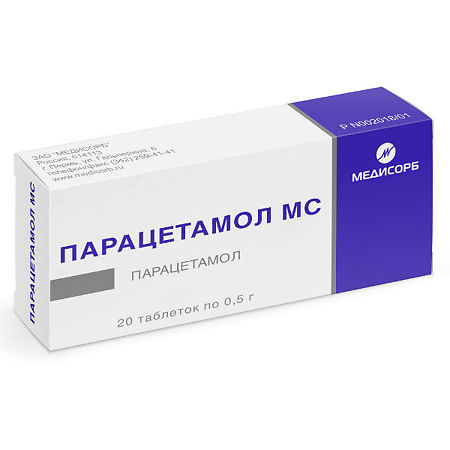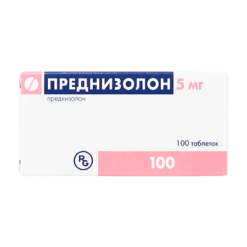No products in the cart.
Paracetamol, tablets 500 mg, 20 pcs.
€1.00
Out of stock
(E-mail when Stock is available)
Description
Paracetamol is an analgesic and antipyretic. It blocks the synthesis of prostaglandins in the central nervous system by inhibiting cyclooxygenase 1 and cyclooxygenase 2, affecting the centers of pain and thermoregulation. It has no anti-inflammatory effect. Due to the absence of influence on the synthesis of prostaglandins in peripheral tissues, it has no negative effect on water-salt metabolism (retention of sodium and water) and gastrointestinal mucosa.
Paracetamol is quickly and almost completely absorbed from the gastrointestinal tract. It binds to plasma proteins by 15%. Paracetamol penetrates the blood-brain barrier. Less than 1% of the dose of paracetamol taken by a nursing mother penetrates into breast milk. The therapeutically effective plasma concentration of paracetamol is achieved when administered at a dose of 10-15 mg/kg body weight. The elimination half-life is 1-4 hours. Paracetamol is metabolized in the liver and excreted in the urine, mainly as glucuronides and sulfated conjugates, less than 5% is excreted unchanged in the urine.
Indications
Indications
To quickly relieve headache, including migraine pain, toothache, neuralgia, muscle and rheumatic pain, as well as algodysmenorrhea, pain from injuries, burns; to reduce fever with colds and the flu.
Active ingredient
Active ingredient
Composition
Composition
Affective ingredient: paracetamol 500 mg,
Auxiliary substances: gelatin, potato starch, stearic acid, milk sugar (lactose).
How to take, the dosage
How to take, the dosage
For adults the single dose of paracetamol is 0.35-0.5 g 3-4 times a day, the maximum single dose for adults is 1.5 g, the maximum daily dose is 3-4 g. The drug should be taken after the meal with plenty of water.
For children from 9 to 12 years old the maximum daily dose is 2 g.
For children from 3 to 6 years old the maximum daily dose is 1-2 g of paracetamol at the rate of 60 mg per 1 kg of body weight in 3-4 doses.
Interaction
Interaction
The drug when taken for a long time increases the effect of indirect anticoagulants (warfarin and other coumarins), which increases the risk of bleeding. Inducers of microsomal oxidation enzymes in the liver (barbiturates, diphenine, carbamazepine, rifampicin, zidovudine, phenytoin, ethanol, flumecinol, phenylbutazone and tricyclic antidepressants) increase the risk of hepatotoxic effects in overdose.
Long-term use of barbiturates reduces the effectiveness of paracetamol.
Ethanol promotes acute pancreatitis.
Inhibitors of microsomal oxidation (cimetidine) reduce the risk of hepatotoxic effects. Concomitant use with other non-steroidal anti-inflammatory drugs increases nephrotoxic effects.
The simultaneous long-term administration of high-dose paracetamol and salicylates increases the risk of renal and bladder cancer. Diflunisal increases the plasma concentration of paracetamol by 50% – the risk of hepatotoxicity.
Myelotoxic drugs increase the manifestations of hematotoxicity of the drug. Metoclopramide and domperidone increase, and cholestyramine reduces the absorption rate of paracetamol. The drug may decrease the activity of uricosuric drugs.
Special Instructions
Special Instructions
Consult your doctor before taking this medicine:
to avoid toxic liver damage, do not take paracetamol with alcoholic drinks, or with people who have a tendency to drink alcohol spirits chronically.
Peripheral blood count and liver function should be monitored during long-term treatment.
Contraindications
Contraindications
With caution: Use with caution in benign hyperbilirubinemia (incl. With caution: use with caution in benign hyperbilirubinemia (including Gilbert’s syndrome), viral hepatitis, alcoholic liver damage, glucose-6-phosphate dehydrogenase deficiency, alcoholism, pregnancy, lactation, elderly people. The drug should not be taken simultaneously with other paracetamol-containing drugs.
Side effects
Side effects
In the recommended doses, the drug is usually well tolerated. Paracetamol rarely causes side effects. Allergic reactions (skin rash, pruritus, urticaria, Quincke’s edema), erythema multiforme exudative (including Stevens-Johnson syndrome), toxic epidermal necrolysis (Lyell syndrome), dizziness, nausea, epigastric pain; anemia, thrombocytopenia, agranulocytosis; insomnia may sometimes be observed. If prolonged use in high doses – the probability of liver and kidney function disorders and hematopoietic system disorders increases.
In the digestive system: nausea, epigastric pain, increased activity of liver enzymes, hepatonecrosis. Endocrine system disorders: hypoglycemia. In case of unusual symptoms consult a physician.
Overdose
Overdose
Signs of paracetamol overdose are nausea, vomiting, stomach pain, pale skin, anorexia. In a day or two, signs of liver damage are determined. In severe cases liver failure and coma develop. N-acetylcysteine is a specific antidote for paracetamol poisoning.
Symptoms: pale skin, anorexia, nausea, vomiting; hepatonecrosis (severity of necrosis depends directly on the degree of overdose). If overdose is suspected, seek medical attention immediately. Toxic effects of the drug in adults may be observed after taking over 10-15 g of paracetamol: increase of “hepatic” transaminases activity, increase of prothrombin time (12-48 hours after intake); clinical picture of liver damage becomes apparent after 1-6 days. Rarely, liver dysfunction develops fulminantly and may be complicated by renal failure (tubular necrosis).
Treatment: the victim should undergo gastric lavage during the first 4 hours of poisoning, take adsorbents (activated charcoal) and consult a physician, administration of SH-group donators and precursors of glutathione synthesis – methionine in 8-9 hours after overdose and N-acetylcysteine – in 12 hours. The need for additional therapeutic measures (further administration of methionine, intravenous administration of N-acetylcysteine) is determined depending on the concentration of paracetamol in the blood, as well as on the time elapsed after its administration.
Pregnancy use
Pregnancy use
Pregnancy, breastfeeding, and children under 3 months of age use with caution.
Similarities
Similarities
Additional information
| Shelf life | 3 years |
|---|---|
| Conditions of storage | Store in a dry, protected from light and out of the reach of children, at a temperature not exceeding + 25 ° C. |
| Manufacturer | Medisorb, Russia |
| Medication form | pills |
| Brand | Medisorb |
Related products
Buy Paracetamol, tablets 500 mg, 20 pcs. with delivery to USA, UK, Europe and over 120 other countries.














